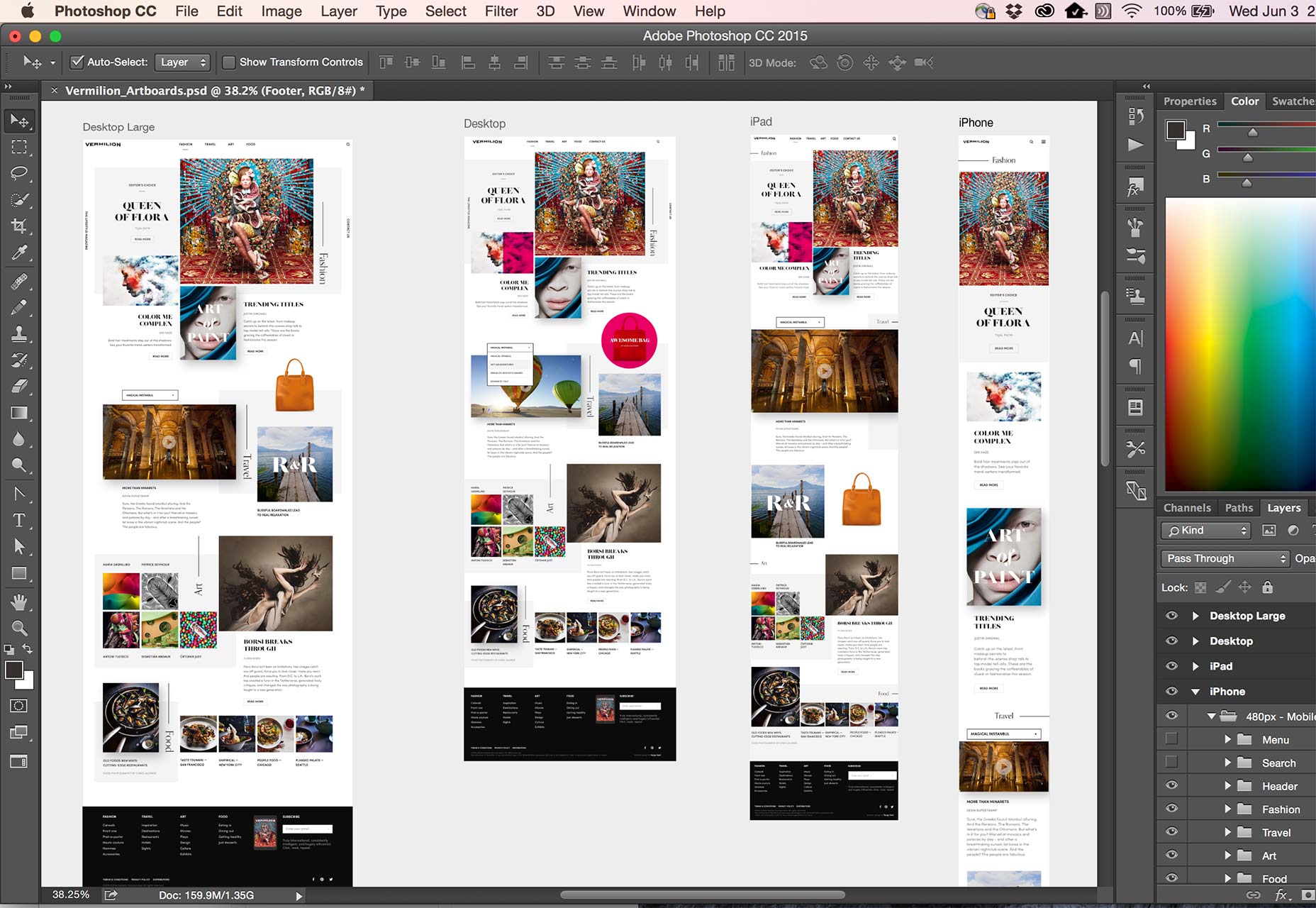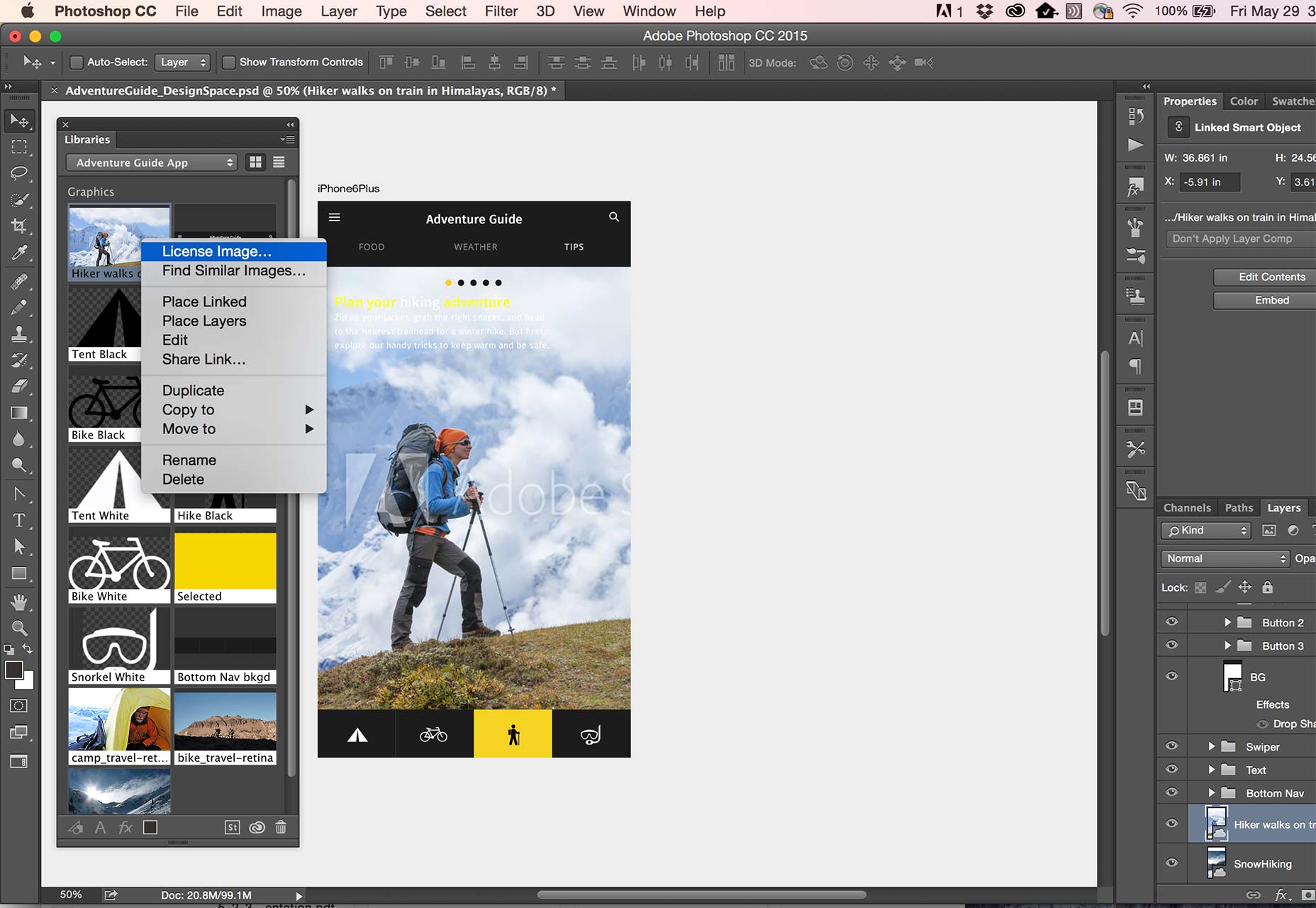
Photoshop CC 2015
In addition to a revamped export process, and a revised live preview (syncing to Adobe Preview CC on iOS devices), there are two significant changes in Photoshop CC 2015 that may well wrest Photoshop out of your applications folder and back onto your dock. [pullquote]Photoshop now (finally) supports multiple art boards[/pullquote] The first major feature is that Adobe Photoshop now (finally) supports multiple art boards. Working with a single art board when designing for multiple screens is infuriating, so this is a huge step towards keeping Photoshop relevant as a design tool. Art boards in Photoshop work much like art boards in Illustrator, and it’s a mystery why it’s taken Adobe so long to add them, if Photoshop is indeed a design tool as well as a bitmap editor. The second major feature is that Photoshop CC 2015 introduces a new design mode named Photoshop Design Space, intended specifically for web and UI designers. Entering this mode in Photoshop will remove superfluous panels and functions (3D for example) and give you a GUI focussed entirely on web and app design. The value of Creative Cloud is that subscribers have access to all of the applications, so it seems reasonable that instead of a web design mode, a dedicated web design app could have been released alongside Photoshop. We asked Scott Morris, Senior Marketing Director for Creative Cloud, why Adobe chose to deliver a UI-centered mode rather than a dedicated product; his answer was that the designers they had spoken to preferred to work in Photoshop.
The reality is that Photoshop has huge market penetration and is a strong vehicle for driving Creative Cloud subscriptions, and that probably had something to do with the decision. However, Photoshop’s Design Space does look like a streamlined Photoshop, and in combination with art boards, introduces some interesting new workflows for web designers.
The value of Creative Cloud is that subscribers have access to all of the applications, so it seems reasonable that instead of a web design mode, a dedicated web design app could have been released alongside Photoshop. We asked Scott Morris, Senior Marketing Director for Creative Cloud, why Adobe chose to deliver a UI-centered mode rather than a dedicated product; his answer was that the designers they had spoken to preferred to work in Photoshop.
The reality is that Photoshop has huge market penetration and is a strong vehicle for driving Creative Cloud subscriptions, and that probably had something to do with the decision. However, Photoshop’s Design Space does look like a streamlined Photoshop, and in combination with art boards, introduces some interesting new workflows for web designers.
Adobe Stock
In a move likely to make considerable waves in the industry, Adobe are moving into stock images. Available now, Adobe Stock launches with 40 million images curtesy of Adobe’s acquisition of Fotolia. The market for stock images is already crowded, but what makes Adobe Stock different is that it is deeply integrated into Creative Cloud apps: browse the Adobe Stock site, find an image that works, and then import it as a low-resolution, watermarked preview directly into your design. You can then work with the image like any other bitmap, scaling, filtering and manipulating. When you (or your client) is satisfied with the design, purchase the image from within the Creative Cloud application and everything you’ve done to the low-res version will automatically be applied to the high-res version. Adobe Stock is priced in addition to a Creative Cloud subscription. It starts at $9.99 per image, or monthly subscriptions are available for $49.99 for 10 images per month, or $199.99 for 750 images per month. If you have any Creative Cloud subscription you’ll automatically qualify for a 40% discount off the subscription rates.
[pullquote]Adobe Stock allows you to rollover image credits to the following month[/pullquote]
In addition, Adobe Stock allows you to rollover image credits to the following month. So if you subscribe to download 10 images, but only use 2, the next month you’ll have 18 available. Rollovers continue month on month up to a maximum of a year.
Adobe Stock will also be accepting submissions of stock images from creative professionals. Currently only photos are being accepted, but video will follow soon, and further asset types are being considered.
Adobe Stock is priced in addition to a Creative Cloud subscription. It starts at $9.99 per image, or monthly subscriptions are available for $49.99 for 10 images per month, or $199.99 for 750 images per month. If you have any Creative Cloud subscription you’ll automatically qualify for a 40% discount off the subscription rates.
[pullquote]Adobe Stock allows you to rollover image credits to the following month[/pullquote]
In addition, Adobe Stock allows you to rollover image credits to the following month. So if you subscribe to download 10 images, but only use 2, the next month you’ll have 18 available. Rollovers continue month on month up to a maximum of a year.
Adobe Stock will also be accepting submissions of stock images from creative professionals. Currently only photos are being accepted, but video will follow soon, and further asset types are being considered.
Further updates
Illustrator has had its zoom magnification boosted from 6400% to 64,000%, and features its own dedicated design mode focussed on charts, graphs and infographics. Dreamweaver has had responsive design built-in, which Adobe claims makes its code production-ready. I’ll reserve judgement on that, but it is certainly a welcome tool for designers quickly mocking up responsive designs. [pullquote]Creative Cloud now features linked assets…so you can update an asset…and…have it update across all your files.[/pullquote] Adobe’s mobile apps, previously only available on iOS are finally making their way onto Android. Shape CC, Color CC, Brush CC, and Photoshop Mix are all now available, with other mobile apps to follow. All of Creative Cloud now features linked assets in CC Libraries, so you can update an asset — a logo for example — and choose to have it update across all your files that use it. Last, but not least, Creative Cloud now makes use of the CreativeSync service to ensure all of your assets are available wherever you need them. Simply stop working on your notebook, move over to your desktop machine and fire up the project; everything will be ready for you to pickup seamlessly where you left off.Conclusion
Performance gains are always welcome, and the Mercury Performance System delivers major gains across the whole Creative Cloud suite, reportedly making it ten times faster than CS6. However, the real focus of this release is on workflow and integration. [pullquote]Photoshop now looks like an application that can be used for design again[/pullquote] Photoshop now looks like an application that can be used for design again, and the deep integration of Adobe Stock is so close to the perfect stock workflow, that it’s difficult to see how rivals stock providers will be able to compete. Creative Cloud 2015 is the result of Adobe continuing along its route to an integrated design eco-system, but happily, it appears they’ve also started listening to their customers.Ben Moss
Ben Moss has designed and coded work for award-winning startups, and global names including IBM, UBS, and the FBI. When he’s not in front of a screen he’s probably out trail-running.
Read Next
3 Essential Design Trends, November 2024
Touchable texture, distinct grids, and two-column designs are some of the most trending website design elements of…
20 Best New Websites, October 2024
Something we’re seeing more and more of is the ‘customizable’ site. Most often, this means a button to swap between…
Exciting New Tools for Designers, October 2024
We’ve got goodies for designers, developers, SEO-ers, content managers, and those of you who wear multiple hats. And,…
15 Best New Fonts, September 2024
Welcome to our roundup of the best new fonts we’ve found on the web in the previous four weeks. In this month’s edition…
By Simon Sterne
3 Essential Design Trends, October 2024
This article is brought to you by Constantino, a renowned company offering premium and affordable website design
You…
A Beginner’s Guide to Using BlueSky for Business Success
In today’s fast-paced digital world, businesses are always on the lookout for new ways to connect with their audience.…
By Louise North
The Importance of Title Tags: Tips and Tricks to Optimize for SEO
When it comes to on-page SEO, there’s one element that plays a pivotal role in both search engine rankings and user…
By Simon Sterne
20 Best New Websites, September 2024
We have a mixed bag for you with both minimalist and maximalist designs, and single pagers alongside much bigger, but…
Exciting New Tools for Designers, September 2024
This time around we are aiming to simplify life, with some light and fast analytics, an all-in-one productivity…
3 Essential Design Trends, September 2024
September's web design trends have a fun, fall feeling ... and we love it. See what's trending in website design this…
Crafting Personalized Experiences with AI
Picture this: You open Netflix, and it’s like the platform just knows what you’re in the mood for. Or maybe you’re…
By Simon Sterne
15 Best New Fonts, August 2024
Welcome to August’s roundup of the best fonts we’ve found over the last few weeks. 2024’s trend for flowing curves and…
By Ben Moss















